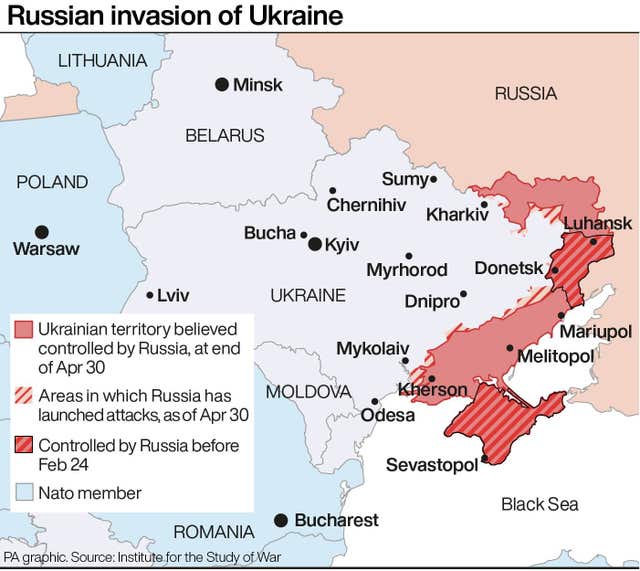Russian forces storming Mariupol steel plant, say Ukrainian fighters
The move comes almost two weeks after Russian president Vladimir Putin ordered his military not to storm the facility, but block it off instead.

Russian forces began storming a sprawling steel plant in the besieged port city of Mariupol on Tuesday, Ukrainian officers said, as a convoy carrying dozens of civilians evacuated from the facility over the weekend arrived in the relative safety of a Ukrainian-controlled city.
Osnat Lubrani, the UN humanitarian co-ordinator for Ukraine, said in a statement that, thanks to the evacuation effort: “One hundred and one women, men, children and older persons could finally leave the bunkers below the Azovstal steelworks and see the daylight after two months.”
The news for those left behind was more grim. The deputy commander of the Azov Regiment holed up in the plant told The Associated Press that Russian forces were storming the facility, which includes a warren of underground tunnels and bunkers. Another Ukrainian officer confirmed the assault on Ukrainian television.
On the messaging app Telegram, deputy commander of Ukraine’s Azov Regiment, Sviatoslav Palamar, said the Russians were mounting a heavy assault on the plant with “the support of armoured vehicles and tanks, with attempts to land troops from boats and a large number of infantry”.
“We’ll do everything that’s possible to repel the assault, but we’re calling for urgent measures to evacuate the civilians that remain inside the plant and to bring them safely,” he said.
He added that throughout the night, the plant was hit with naval artillery fire and airstrikes. Two civilian women were killed and 10 civilians were wounded, he added.
The assault began almost two weeks after Russian president Vladimir Putin ordered his military not to storm the plant, but rather block it off.

At a reception centre, stretchers and wheelchairs were lined up, children’s shoes dangled from a shopping trolley and a pile of toys waited for the first convoy of civilians whose evacuation was being overseen by the United Nations and Red Cross.
The arrival of buses and ambulances was a rare glimmer of good news in the nearly 10-week conflict that has killed thousands, forced millions to flee the country, laid waste to towns and cities, and shifted the post-Cold War balance of power in eastern Europe.
“Over the past days, travelling with the evacuees, I have heard mothers, children and frail grandparents speak about the trauma of living day after day under unrelenting heavy shelling and the fear of death, and with extreme lack of water, food and sanitation,” Ms Lubrani said.
“They spoke of the hell they have experienced since this war started, seeking refuge in the Azovstal plant, many being separated from family members whose fate they still don’t know.”

Some decided not to travel all the way to Zaporizhzhia, where a total of 127 people arrived on Tuesday, she added.
The Russian military said earlier that some evacuees had chosen to stay in separatist areas. In the past, Ukraine has accused Moscow’s troops of taking civilians against their will to Russia or Russian-controlled areas — something the Kremlin has denied.
Mariupol has come to symbolise the human misery inflicted by the war. A Russian siege has trapped civilians with little access to food, water and electricity, as Moscow’s forces pounded the city to rubble.
The plant — where about 1,000 civilians sought shelter along with some 2,000 fighters who have refused to surrender — has particularly transfixed the outside world.

After failing to take Kyiv in the early weeks of the war, Russia withdrew some of its forces and then said it would switch its focus to Ukraine’s eastern industrial heartland of the Donbas.
Mariupol lies in this region, and its capture would deprive Ukraine of a vital port, allow Russia to establish a land corridor to the Crimean Peninsula, which it seized from Ukraine in 2014, and free up troops for fighting elsewhere in the Donbas.
Michael Carpenter, US ambassador to the Organisation for Security and Co-operation in Europe, said on Monday that the US believed the Kremlin planned to annex much of eastern Ukraine and recognise the southern city of Kherson as an independent republic. Neither move would be recognised by the United States or its allies, he said.

Getting a full picture of the unfolding battle in the east has been difficult because airstrikes and artillery barrages have made it extremely dangerous for reporters to move around. Both Ukraine and the Moscow-backed rebels fighting in the east have introduced tight restrictions on reporting.
But so far, Russia’s troops and their allied separatist forces appear to have made only minor gains, taking several small towns as they try to advance in relatively small groups against staunch Ukrainian resistance.
Meanwhile, Mr Putin has told French president Emmanuel Macron that Moscow is ready for talks with Ukraine.
The Kremlin said in its readout of Tuesday’s call that “despite Kyiv’s inconsistency and its lack of readiness for serious work, the Russian side is still ready for dialogue”.
The Kremlin added that Mr Putin also informed Mr Macron about the course of Russia’s “special military operation”. It added that the two leaders also discussed global food security and that the Russian leader underlined that western sanctions had exacerbated the situation.





